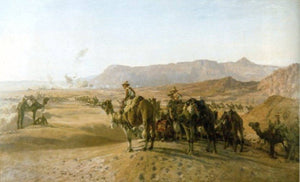The ANZACs and the Imperial Camel Corps
ANZAC Day – 25 April – is a day of commemoration held on the anniversary of the day Australian and New Zealand soldiers landed on Gallipoli in 1915. We also recognize the more than 102, 000 Australians who sacrificed their lives for their country and more than 1.5 million service men and women who served our country in all wars, conflict and peacekeeping operations.
Many people are unaware of the significant contribution that Camels made to the WW1 effort and the role of Australian and New Zealand Soldiers in the Imperial Camel Corps.

The Imperial Camel Corps, a camel-mounted infantry brigade, was raised in January 1916 and was attached to the Anzac Mounted Division, and therefore Harry Chauvel, who commanded the whole division.
The brigade had one battalion each from Great Britain and New Zealand, and two from Australia. It started small but eventually grew to a strength of 3380 men and 3880 camels -500 more camels than men.
The camels could cover an average distance of 4.8 km an hour, or 9.7 km an hour trotting while carrying a soldier, his equipment, and supplies.

The four companies were expected to operate as independent units that travelled by camel but then dismounted to fight as infantrymen, just as the Light Horse troops did.
However it was soon discovered that camels were not as nervous as horses when faced with artillery and rifle fire, so one man could look after 12 to 16 camels as opposed to just 4 horses, once the troopers had dismounted.
The whole of the Camel Corps was mounted on camels. No wheeled vehicles of any sort were attached. As each man always had to have five days’ supply of food and water for himself, and a similar supply of grain for his mount as well as over two hundred rounds of ammunition, the whole Brigade could, at an hour’s notice, go off into the blue for five days without any communication with or assistance from its base.

The Camel Corps started off being asked to make along patrols in the Western Desert in 1916, with only brief skirmishes with horsemen, but after demonstrating their fighting qualities, the corps was transferred to the Sinai Desert in late 1916, to take part in operations against the Turkish army.
The battalions of the ICC fought alongside Australian light horse units at Romani, Magdhaba and Rafa, and remained an integral part of the force that advanced north through Palestine in 1917 and 1918.
It suffered particularly heavily during the Second Battle of Gaza in April 1917, and in the operations conducted in November to destroy the Turkish defensive line between Gaza and Beersheba, after the famous Light Horse charge at Beersheba that turned the course of the war.
The Imperial Camel Corps had the distinction of operating in more areas than any other body of troops in the Middle East campaign, including alongside Lawrence’s Arab guerrillas harassing the Hejaz railway.
The bulk of the ICC was disbanded in June 1918 and the Australians were used to form the 14thand 15thLight Horse regiments.
In the two years that the Camel Corps was in existence, it lost 240 men, 106 British, 84 Australians, 41 New Zealanders, and nine men from India. I’ve searched for the number of camels that died during the war but it seems to be an unknown quantity. However, it has been estimated that in excess of a million camels were lost during World War One.
Thanks to Sally Cripps who provided much of the information in this article.
https://summerlandcamels.com.au/blogs/news/chauvel-and-the-camel-corps
https://www.awm.gov.au/visit/exhibitions/fiftyaustralians/7
https://www.awm.gov.au/collection/P11028485
https://www.awm.gov.au/learn/schools/resources/1916/imperial-camel-corps


